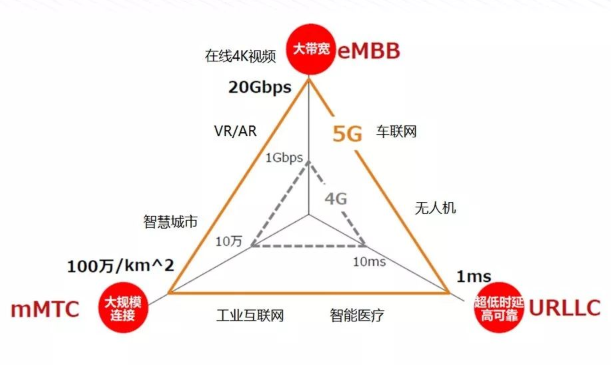1G realizes mobile call, 2G realizes SMS, digital voice and mobile Internet access, 3G brings picture based mobile Internet, and 4G promotes the development of mobile video. 5G network is regarded as the basis for the interconnection of things, vehicles and other things in the future. At the same time, 5g popularization will make technologies including virtual reality and augmented reality mainstream. 4G network is designed for mobile phones and is not optimized for the Internet of things. 5G technology provides Super bandwidth for the Internet of things. Compared with 4G, 5G network can support more than 10 times of devices. Intelligent sensors that can be applied to automatic driving, ultra-high definition video, virtual reality and interconnection of all things. 5g network has three main characteristics: very high rate, great capacity and very low delay. Compared with 4G network, the transmission rate increases by 10 ~ 100 times, the peak transmission rate reaches 10Gbit / s, the end-to-end delay reaches ms level, the density of connected equipment increases by 10 ~ 100 times, the traffic density increases by 1000 times, and the spectral efficiency increases by 5 ~ 10 times, which can ensure the user experience at the speed of 500km / h. Unlike 2G, 3G and 4G, which only face people to people communication, 5G considers the interconnection between people and things, and between things and things. In the 5G indicators accepted by the global telecommunication union, in addition to the requirements for the original base station peak rate, 5G puts forward eight indicators: base station peak rate, user experience rate, spectrum efficiency, traffic space capacity, mobile performance, network energy efficiency, connection density and delay.
Popular understanding means that the biggest difference of 5G is that it will really help the whole society build "interconnection of all things". For example, the massive Internet of things such as driverless, cloud computing, wearable devices, smart home and telemedicine can realize the real interconnection of things / things and people / things when 5G is mature enough. Disruptive applications such as new technological revolution, artificial intelligence, new intelligent hardware platform VR, new travel technology, unmanned driving, and new scene interconnection of all things can be launched with the help of 5G.
1、 Technical features of 5G: interconnection of all things, open architecture and unlimited access
"The arrival of 5G is not only to solve the problem of basic communication, but also to solve the direct interconnection between people, people and things, things and things.
If 1G-2G-3G-4G is a straight-line evolution route, then 5G is a horizontal expansion from "straight line" to "face".
The goal of 5G is to provide unlimited information access and enable anyone and anything to share data anytime, anywhere, benefiting individuals, enterprises and society.
5G is an open and software definable architecture for the interconnection of all things: on this architecture, there are different virtual network slices to adapt to thousands of 5G application scenarios. In addition to the communication between people, 5G will provide a platform enabling Internet of things (IOT), build a comprehensive information ecosystem centered on users, and provide various possibilities and cross-border integration.
2、 5G scene advantages
Low power and large connection
Continuous wide area coverage
Hot spot high capacity
Low delay and high reliability
3、 5G speed advantage
There are many legends and experiments about the speed of 5G: some data say it is 66 times that of 4G network; According to foreign media reports, the head of the 5G research project at the University of Surrey told the media a few days ago that the mobile transmission speed of the 5G network has now exceeded 1tbps, 60000 times that of the current 4G network. The wireless transmission speed of 1tbps can be realized within 100m under laboratory conditions, and it is expected to be officially put into commercial use in the first half of 2018. Delay: the delay is as low as 1 millisecond. In 3G network, the delay is about 100 milliseconds, in 4G network, the delay is 20 to 30 milliseconds, and in 5G network, the delay can be shortened to 1 millisecond, which is enough to support the auto driving function. Network capacity: mainstream manufacturers predict that 5G network capacity will be 100 to 1000 times that of 4G. Download speed: up to 10Gbps peak rate. The fastest download speed of 4G is about 150MB per second, but the fastest download speed of 5Gis 10GB per second. Downloading a 5G HD movie will reduce from 70 minutes in 3G era and 7 minutes in 4G era to just 6 seconds in 5G era.




